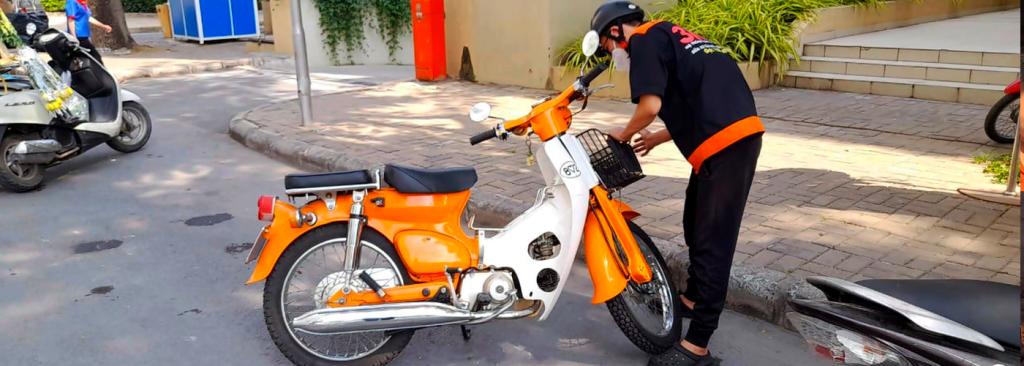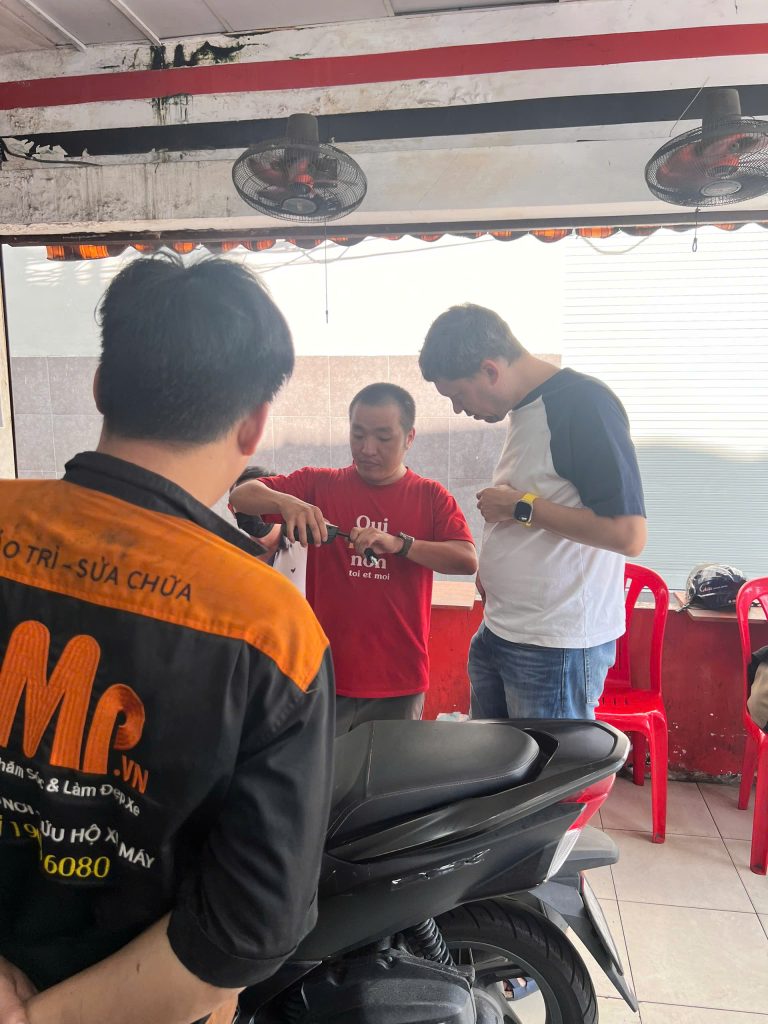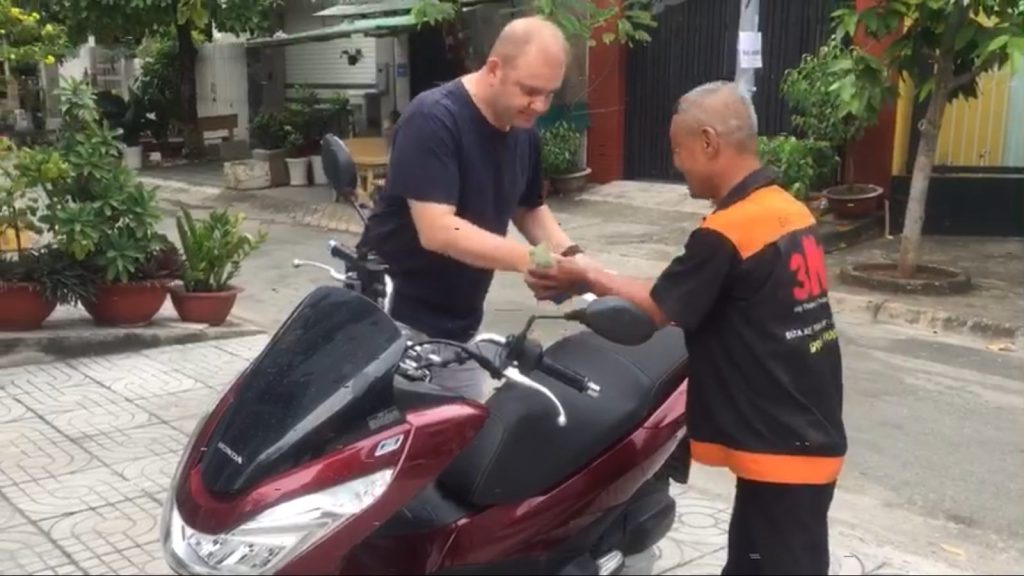You’re looking for guidance on what to look out for and how to check the condition of a used motorcycle before buying. This is crucial to avoid purchasing a low-quality bike. Here’s a detailed guide:

I. Check the Legal Documents before buy secondhand motorbike
This is the most critical step to ensure the motorcycle isn’t stolen, fraudulent, or involved in disputes:
- Vehicle Registration Certificate (Cà Vẹt Xe):
- Information: Make sure the frame number (số khung) and engine number (số máy) on the registration match those physically on the bike.
- Owner: Verify if the name on the registration matches the person selling the bike. If not, ask for a clear explanation of their relationship and the reason. Request a power of attorney or a prior bill of sale/purchase agreement if available.
- Forged Documents: Carefully examine the seal and signature on the registration. Be cautious if you notice any signs of erasure or forgery. For newer bikes, you might be able to use a QR code scanning app if available on the document.
- License Plate: Ensure the license plate on the motorcycle matches the one on the registration.
- Bill of Sale/Power of Attorney (if applicable): If the seller isn’t the owner listed on the registration, ask to see a notarized bill of sale or a power of attorney.
- Installment Payment: Ask if the bike is still under an installment plan. Request documentation proving that all payments have been completed.
- Vehicle Origin: Avoid buying bikes with unclear origins or those priced suspiciously low compared to the market.

II. Inspect motorbike – the Exterior
The exterior can reveal clues about the bike’s usage history and maintenance:
- Overall Appearance:
- Observe the bike under good lighting from multiple angles.
- Check for symmetry; ensure it isn’t tilted, bent, or warped.
- Paint Color: Is the paint consistent? Are there any signs of repainting or touch-ups meant to hide cracks or major scratches?
- Lights, Mirrors, Turn Signals:
- Test the headlights, taillights, and turn signals to ensure they work properly (turn on/off, bright, blink evenly).
- Check that the rearview mirrors are present, intact, and correctly positioned.
- Tires:
- Examine the tire tread wear. If it’s heavily worn or unevenly worn (only on one side), the bike may have high mileage or issues with its suspension/frame.
- Check for cracks, dry rot, or signs of multiple patches.
- Wheels and Rims (Mâm/Nan Hoa):
- Inspect the rims for any bends, cracks, or damage.
- For spoke wheels, check if the spokes are rusty, loose, or broken.
- Spin the wheels to see if they wobble or shake.
- Seat:
- Check if the seat is torn, worn, or cracked.
- Assess the cushioning and comfort of the seat.
- Exhaust Pipe (Pô Xe):
- Check for dents, holes, or excessive rust.
- Observe the color of the smoke when the engine is running (more on this in the engine section).
- Parts and Screws:
- Inspect all joints and screws on the bike’s body and frame. If there are signs of frequent removal, or if screws are stripped, the bike may have undergone significant repairs or parts replacements.
- Check if plastic parts or decals are cracked, broken, or heavily faded.
III. Inspect motorbike – the Engine and Performance
This is the core section for assessing the true quality of the motorcycle:
- Starting the Engine:
- Ignition: Try starting the bike using both the electric start button and the kick start. See if it starts easily (within a few attempts) or if it requires many tries.
- Engine Sound: Once started, the engine sound should be smooth, consistent, with no strange knocking, clattering, or unusual howling noises.
- Starting Conditions: Check both when the engine is cold (overnight) and when it’s already warm.
- Engine Sound During Operation:
- Idle (Garanti): At idle, the engine sound should be smooth and steady, without suddenly dying.
- Acceleration: Gently twist the throttle and hold it at various RPMs. Listen for straining, howling, or any metallic clashing sounds.
- Deceleration: When suddenly decelerating, does the engine die or produce popping sounds from the exhaust?
- Exhaust Smoke:
- Thick White Smoke: If the bike emits a lot of thick white smoke with a burning smell, it’s a sign of worn piston rings or burning oil. This indicates a costly repair.
- Black Smoke: Black smoke can indicate rich fuel mixture, a dirty air filter, or issues with the combustion chamber.
- Blue Smoke: A sign of burning oil.
- Clear Smoke: A good bike usually emits clear (colorless) smoke or a very faint gray smoke when first started on a cold morning.
- Gearbox (for manual bikes):
- Try shifting through all gears (1, 2, 3, 4…). See if it shifts smoothly, without getting stuck or jumping out of gear.
- For clutch bikes, check if the clutch engages properly and doesn’t slip during acceleration.
- Transmission System (for automatic scooters):
- When accelerating, does the bike feel sluggish, jerky, or produce loud howling noises from the CVT/clutch assembly?
- Check the bike’s responsiveness during acceleration.
- Brake System:
- Test both the front and rear brakes at low speeds. The brakes should engage effectively, without jerking, locking up, or feeling too loose.
- Check brake fluid and brake pads.
- Suspension System (Phuộc):
- Front Forks: Press down firmly on the front of the bike and release. The forks should compress and rebound smoothly, without strange noises or oil leaks.
- Rear Shocks: Sit on the bike or have someone else sit on it and bounce. The shocks should rebound well, without creaking noises or oil leaks.
- Electrical System:
- Check the horn, headlights (high/low beam), turn signals, taillights, and brake lights to ensure they all work.
- Verify that the speedometer, fuel gauge, and ODO meter work accurately.
- Check the battery: Does the bike start strongly? Are all electrical components bright?

IV. Test Ride the Motorcycle
This step is essential to get a real feel for the bike’s condition:
- Ride at Various Speeds: Ride the bike at different speeds (low, medium, high) to assess its acceleration and stability.
- Test on Straight and Curved Roads: See if the bike pulls to one side, leans, or wobbles.
- Cornering: Does the bike feel stable when turning?
- Emergency Braking (Safely): Test the brake effectiveness at a moderate speed.
- Listen Closely: Pay attention to any strange noises coming from the engine, gearbox, suspension, or brakes while riding.
- Feel: Does the bike vibrate excessively? Does it feel solid and stable?
V. Other Important Considerations
- Ask About the Bike’s History:
- How many kilometers has the bike traveled (ODO)? Be cautious of bikes with suspiciously low ODO readings for their age (they might be tampered with).
- Where was the bike regularly serviced? Are there any service records?
- Has the bike ever been in an accident, submerged in water, or had a major engine overhaul?
- Bring a Mechanic or Experienced Friend: If you’re not confident in your own inspection skills, ask a friend with motorcycle experience or a mechanic to come along and help you check the bike.
- Be Patient and Don’t Rush: Don’t make a hasty decision. Take your time to inspect thoroughly. If you have any doubts, walk away or ask the seller to take the bike to a professional workshop for inspection.
- Research Market Prices: Look up prices for the model you’re interested in on classified websites or used bike marketplaces to get a general idea and avoid overpaying.
- Negotiate the Price: Always negotiate the price after a thorough inspection and after identifying any necessary repairs or maintenance items.
- Purchase Agreement: When buy secondhand motorbike, create a written purchase agreement, or ideally, have it notarized. Include clear information about the seller, buyer, vehicle details, and price to protect your legal rights.
By following these inspection steps, you can minimize risks and find a good quality used motorcycle that fits your needs. Good luck!

Used Motorcycle Inspection Service with Big Jose Motorbike Mechanics
When you’re looking to buy secondhand motorbike, a thorough inspection of its condition is incredibly important to avoid unnecessary risks. Don’t let a lack of assessment experience lead you to buy a “money pit”!
At Big Jose Motorbike, we pride ourselves on having a team of mechanics with many years of experience in the trade, who can be your invaluable “consultants” in this process. With keen eyes and extensive expertise, Big Jose Motorbike mechanics will assist you in comprehensively checking the condition of the used motorcycle you’re considering.
We will provide you with an overall assessment of the bike’s current quality, point out issues that require immediate attention, and analyze repairs that might arise in the near future. This detailed information will serve as a solid foundation to help you negotiate the price effectively, ensuring you purchase the bike at a fair value.
To use Big Jose Motorbike’s inspection service, please book an appointment 1-2 days in advance so we can schedule our mechanics during off-peak hours. You can bring the motorcycle to the Big Jose Motorbike workshop for inspection, or if needed, we can send a mechanic to your location to assist you.
The cost for a motorcycle inspection at Big Jose Motorbike’s workshop ranges from 200,000đ – 500,000đ, depending on the complexity and type of bike. If you require a 3MP mechanic to inspect the bike at your location, the on-site service fee will be 100,000đ – 200,000đ (this does not include the inspection fee itself).
Let the experience of Big Jose Motorbike mechanics help you make a smart decision when buying a used motorcycle, bringing you complete peace of mind with your transaction!

